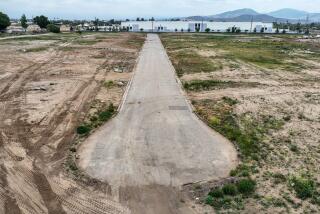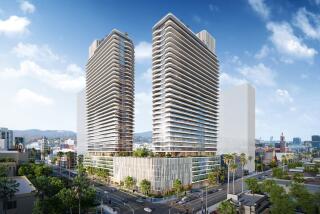City Panel OKs Special Funding for Development : Sylmar: Committee approves studies needed to set up assessment district to provide tax-free bonds.
A Los Angeles city budget panel tentatively approved the use of special financing Tuesday to help a private developer build a long-planned business park, residential development and 18-hole golf course in Sylmar.
The city’s Budget and Finance Committee approved the studies needed to set up a Mello-Roos assessment district to provide tax-free municipal bonds for construction of the so-called Silver Oaks project near the intersection of the Golden State and Foothill freeways.
The 262-acre project--once known as the Sunset Farms Business Park--calls for the construction of 1.9 million square feet of office space, a golf course, a clubhouse and 46 single-family homes on rural, vacant land in the cradle of the freeway intersection.
Although the project won city approval in 1990, it has remained on hold in part because of the recession that put a freeze on development throughout Los Angeles County.
But Mark S. Armbruster, an attorney representing the developer, Royal-Clark Development Co., said approval of the Mello-Roos district can jump-start the project by providing tax-free municipal bonds for the developer.
“We look at this as a win-win situation for everybody,” he said.
Typically, Mello-Roos districts are created when a developer puts up land as collateral for the bonds, which the city then sells to investors. The money from the bonds is turned over to the developer to make public improvements that are called for in the project. The bonds are repaid through additional levies on the property owner’s tax bills.
In this case, the sole property owner is the developer who will be responsible for paying the levy at least until parcels of the project are sold off.
Although the city assumes no liability by approving the Mello-Roos financing, the City Council has in the past agreed to use this type of financing rarely and only if it provides “extraordinary public benefit.”
Armbruster told the Budget and Finance Committee that the public benefit provided by the project would be the “thousands of jobs” created by the development as well as the nearby street improvements paid for through the project.
If the committee’s action is approved by the full City Council in the next month, the developer will have to hire a consultant to study the project and make sure it can provide the taxes and public improvements that the developer claims will be created.
During discussions of the project, freshman Councilman Mike Feuer and Councilwoman Rita Walters said they were hesitant to approve the funding mechanism because they knew little about the project.
“This project is enormous,” Feuer said.
But they agreed to move ahead with the study after Armbruster told them that an environmental study on the project was completed in 1989 and the development had “widespread community support.”
Actually, when the project was originally proposed in 1988, it generated strong community opposition from nearby residents who worried that the development would destroy the rural atmosphere of the area and increase traffic congestion.
But by March, 1990, when the Planning Commission approved the project, the developer had mollified most opponents with promises to pay for improvements to adjacent neighborhoods and streets.
Armbruster said the 18-hole golf course should be completed in late 1996 or early 1997, with the business park and residential development being built soon after.
More to Read
Sign up for Essential California
The most important California stories and recommendations in your inbox every morning.
You may occasionally receive promotional content from the Los Angeles Times.











